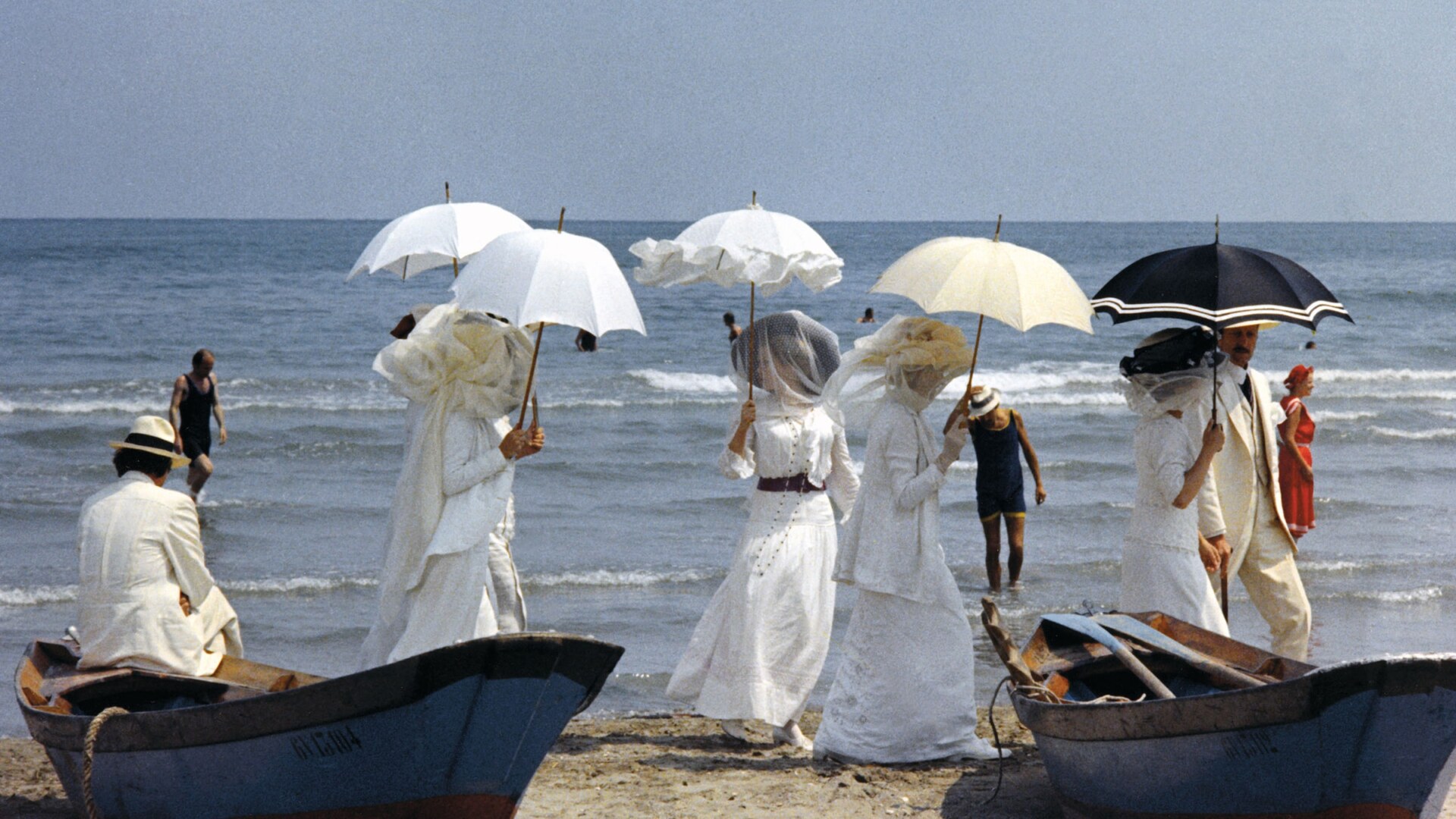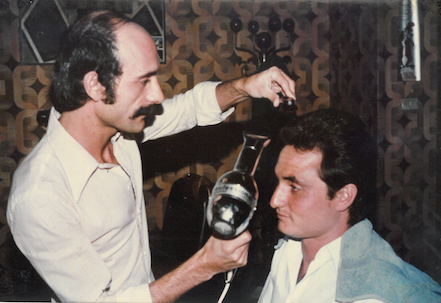Fellini, Antonioni, Visconti: Italian cinema has its own Holy Trinity.
Together, these three directors managed to represent and interpret Italian society through a crucial time in our history–from the desolation left by WWII to the economic miracle and beyond. If Fellini blended memories and dream-like atmospheres into the everyday and Antonioni explored the existential crisis of a bourgeoisie bored to death, Visconti reclaimed for himself drama of the purest quality, preferably set among an aristocracy in perpetual decline.
Critics have often accused spruced-up Visconti of being too decadent and magniloquent, though this exact quality–the director’s style of overfeeding his films with suggestions from literature, music and theater; stunning interiors; and sumptuous costumes–eventually became his unique trademark.
Visconti knew a thing or two about the upper class, having been born into one of the country’s most notable families: his father was Duke of Grazzano Visconti, Count of Lonate Pozzolo, and chamberlain of the king of Italy Vittorio Emanuele III; his mother, more prosaically, was the heiress of the biggest pharmaceutical company of the country.
Visconti would interpret his birthday, November 2nd, 1906–the Day of the Dead–as the first manifestation of his rebellious spirit: “I came into the world on the Day of the Dead, by a coincidence that will always remain scandalous, perhaps twenty-four hours late on All Saints’ Day…”
And rebellious he was. In the over 30 years of his career, very few of his films didn’t attract censorship or some sort of scandal, starting with his debut feature. Obsession (Ossessione, 1943), based on James M. Cain’s tragic novel The Postman Always Rings Twice, is a passionate drama about a love triangle. The movie allegedly escaped the clutches of Fascist censorship only because Mussolini himself liked it.
Visconti’s direction of theater plays, for which he is unfairly little-known, was even more daring. Browsing their titles, one suspects he cherry-picked his subjects from Arthur Miller’s Death of a Salesman, Tennessee Williams’ A Streetcar Named Desire and Jean Cocteau’s Les Parents terribles with the sole purpose of shocking the public.
Homosexuality, torrid affairs, alcoholism, incest, mental illness, manias at all levels: no taboo or uncomfortable topic was left behind. The Italian society of the time, entangled in a suffocating mix of moralism and Catholic rhetoric, badly needed such impact therapy.
Most of Visconti’s films develop around the same themes, championing edgy characters such as the flamboyant King Ludwig II of Bavaria in Ludwig (1973), or the wanton Italian countess Livia Serpieri in Senso (1954). Seduced, taken advantage of and eventually abandoned by the (oh-so-handsome) Austrian Lieutenant Franz Mahler, the countess realizes his toxicity only after the two hours the film lasts. She turns him in, effectively condemning her lover to death, but eventually flips out and drags herself (and her expensive frock) around Venice desperately crying his name: “Franz? Fraanz? Fraaaaanz!?” The film was heavily censored. Many battle scenes were considered defeatist, damaging the image of the Italian army, and many of the romantic ones were deemed obscene.
Two of Visconti’s most known films, Rocco and His Brothers (Rocco e i Suoi Fratelli,1960) and The Damned (La Caduta degli Dei, 1969), are perfect examples of the family tragedies so dear to the director, though set on opposing backgrounds. Whether it’s “the humanity that suffers and hopes” (a coded expression for the working class used in Italy back then) or a self-destructive family of German tycoons dealing with the rise of Nazism, that aforementioned decadence is guaranteed with Visconti.
Incidentally, the two films gave us pretty iconic homoerotic scenes: actors Alain Delon and Renato Salvatori showering after boxing training and the sequence on the Night of the Long Knives when Nazi brownshirts behave like they were at Berghain on a Saturday night–poetic licenses included.
To understand Visconti’s complexity, you only have to consider the director’s triple identity: aristocratic, homosexual and communist.
Successfully combining any two of these three instances during these times would already have been exceptional–from the mutually exclusive “aristocratic and communist” to the equally unimaginable “homosexual and communist”. It mattered little that Visconti had actively helped the resistance and had been imprisoned by the SS during the last years of WWII. Declared homosexuals were not allowed in the Communist Party.
The list of real estates owned by the Viscontis, however, would certainly scream “aristocratic” more than “communist”. The director spent his childhood and then adult life between the family’s palace in Milan and their many other properties: the villa in Cernobbio on Lake Como (one of the biggest in the area, way before George Clooney made it cool); the castle in the countryside near Piacenza; the Roman villa on Via Salaria, shared for a long time with his assistant-turned-lover-turned-partner Franco Zeffirelli; and the mythological Villa la Colombaia on Ischia, with its pointed arches, Art Nouveau interiors, vases in alabaster, floral wallpapers, Klimt and Matisse on the walls, and blue hydrangeas–picked from the garden designed by Visconti himself and grown in quantities sufficient to regularly fill every of the 25 rooms in the estate.

Villa La Colombaia, Ischia
The more plausible combo, “aristocratic and homosexual”, has given us, through history, quite a few juicy pieces of gossip and some good pages of literature, but rarely psychologically-balanced individuals. In Visconti’s case, it added character to somebody already larger than life, spawning a whole list of enjoyable anecdotes.
In accordance with his origins, he acted as a feudal lord, treating everybody in his crew as if they were his servants. He wouldn’t pay his assistants for months, only to reward them with expensive silk handkerchiefs, but he would rush to sell the family’s jewels to secure enough funds to keep shooting La Terra Trema (1948) when its production got short of cash. He would make his actresses cry, then gift them diamonds for Christmas. And they, first upset, then incredulous at the look of those huge rocks on their fingers, would comment: “A real gentleman!” And then: his style of scenography filled with expensive furniture; the thousands of wax candles that had to be lit, re-lit and replaced at the start of each shooting session for the Leopard’s famous ball scene; the human blood sourced from a Roman hospital to “add reality” to the scene of the murder of The Damned’s patriarch (much to Dirk Bogarde’s horror).
Protected by his name, Visconti couldn’t care less of what others thought about him.
Personality develops early on, during childhood. I won’t give in to the temptation of psychoanalyzing Visconti’s sexuality in relation to his mother, though I can see more than a red flag there.
I’ll just describe her: rich as Croesus, she was incredibly well-read, as beautiful as she was strict, and hyper-catholic. Luchino and his siblings would have to wake up at 5:30am everyday, even during winter time, to follow their oppressive tutoring.
Years later, actress Silvana Mangano, who had been cast to play the mother of the beautiful Tadzio in Death in Venice (1971), would recall how Visconti kept testing her ability to handle the veil of her costume to see if she could wear it as elegantly as his mother.
To all of this, add the asphyxiating expectations of the upper class. The desire to stand out, be validated or at least noticed, must have been overpowering. It’s no wonder he was drawn to loud lavishness. And for all of these reasons and more, Visconti stood out indeed.







